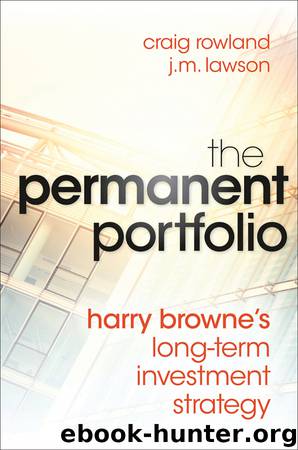The Permanent Portfolio by Craig Rowland & J. M. Lawson

Author:Craig Rowland & J. M. Lawson
Language: eng
Format: epub, mobi
Publisher: John Wiley & Sons, Ltd.
Published: 2012-08-27T16:00:00+00:00
Investors can't afford to just match inflation; they need to beat it. No exceptions. To not do this means that inflation will definitely erode your life savings down to dangerously low levels over the years.
Only Real Returns Matter
It's important to emphasize again that only real returns matter to an investor. The good news is that the Permanent Portfolio can provide you with both consistent real returns, as well as a smooth ride along the way. This matter of consistent real returns is why Table 3.1 at the beginning of the chapter is so important. The portfolio didn't just earn solid returns; it was able to do it no matter what inflation was doing in the broad economy. Over the last 40 years the Permanent Portfolio has had real annual returns in the 3 to 6 percent range over all rolling 10-year periods. That means that there is no 10-year period over the past 40 years where the portfolio failed to beat inflation by at least 3 percent, and the portfolio was able to beat inflation by as much as 6 percent over some periods.
A popular investment strategy is to allocate 60 percent of a portfolio's assets to stocks and 40 percent to bonds. We will call this approach the “60/40 portfolio.” This portfolio is a fine strategy and has performed reasonably well over most periods. However, what you find with this type of portfolio is that it will have some periods when the portfolio lags inflation or barely keeps pace. The periods of high inflation in the 1970s, for example, caused stock-and-bond-only portfolios to see multi-year periods of negative real returns. In other words, investors were losing money over extended periods. In fact, just about any portfolio that only held stocks and bonds during the 1970s performed poorly on an inflation-adjusted basis, no matter what percentage allocations it used
When comparing any strategy to the Permanent Portfolio, it is normally the multi-year returns that are the most telling. Table 3.6 illustrates several multi-year comparisons of how the Permanent Portfolio's performance compared to a 60/40 portfolio. A start year of 2000 would mean how the portfolio did from 2000–2002 for 3 years, 2000–2004 for 5 years, and 2000–2009 for 10 years. The table is showing what returns you would have received if you had invested in that year and waited 3, 5, or 10 years into the future.
Table 3.6 Multi-year Real Returns for Permanent Portfolio Compared to 60/40 Stock/Bond Portfolio from 1972 to 2011.
Download
The Permanent Portfolio by Craig Rowland & J. M. Lawson.mobi
This site does not store any files on its server. We only index and link to content provided by other sites. Please contact the content providers to delete copyright contents if any and email us, we'll remove relevant links or contents immediately.
Rich Dad Poor Dad by Robert T. Kiyosaki(6186)
Pioneering Portfolio Management by David F. Swensen(6084)
How To Win Friends and Influence People by Dale Carnegie(4341)
The Money Culture by Michael Lewis(3851)
The Dhandho Investor by Mohnish Pabrai(3566)
The Wisdom of Finance by Mihir Desai(3532)
Liar's Poker by Michael Lewis(3229)
The Intelligent Investor by Benjamin Graham Jason Zweig(2937)
The ONE Thing by Gary Keller(2922)
Mastering Bitcoin: Programming the Open Blockchain by Andreas M. Antonopoulos(2895)
Fooled by Randomness: The Hidden Role of Chance in Life and in the Markets by Nassim Nicholas Taleb(2868)
Rich Dad Poor Dad: What The Rich Teach Their Kids About Money - That The Poor And Middle Class Do Not! by Robert T. Kiyosaki(2836)
Investing For Dummies by Eric Tyson(2800)
How to Win Friends and Influence People by Dale Carnegie(2799)
How to Day Trade for a Living: Tools, Tactics, Money Management, Discipline and Trading Psychology by Andrew Aziz(2787)
Market Wizards by Jack D. Schwager(2545)
Zero Hour by Harry S. Dent Jr. & Andrew Pancholi(2537)
How to Pay Zero Taxes, 2018 by Jeff A. Schnepper(2503)
Rich Dad's Guide to Investing by Robert T. Kiyosaki(2412)
